(english) Ralf Schreiber arbeitet mit Elektronik,
mit Solarzellen, Motoren und Kleinstlautsprechern. Seine spielerischen
und experimentellen Arbeiten erzeugen leise Klänge und kleinste
Bewegungen und beschäftigen sich dabei mit schwachenergetischen
Transformations-Prozessen (der Wandlung von Licht in Bewegung und Klang).
Schwerpunkt seiner Arbeiten bildet das Langzeitprojekt "Living
Particles" mit immer neuen Konstellationen kleinster, miteinander
kommunizierender und interagierender Mini-Roboter. In der Oberwelt ist
eine neue Variante der "Living Particles" zu sehen und zu
hören.
"Living Particles",
Autonome audiokinetische Installationen (2000-2010)
Mithilfe simpler, analoger, elektronischer Schaltungen baut Ralf Schreiber
kleine Module und einfache Miniaturroboter auf. Alle Einheiten sind
über Solarzellen mit Energie versorgt und arbeiten autonom. Sie
erzeugen leise, variable Klänge und kleinste Bewegungen. Die einzelnen
Module werden untereinander zu einem komplexen System verschaltet. Das
Energie-Potential der einzelnen Module und der Installationen wird auf
einem sehr niedrigen energetischem Niveau gehalten, wobei die Schwelle
so gewählt wird, dass gerade etwas passiert. Aufgrund der Mangelversorgung
durch die Solarmodule arbeiten die Schaltungen astabil und erzeugen
spezielle Bewegungs- und Klangpattern, die sich rhythmisch und chaotisch
verdichten. Es geht dabei um einen minimalistischen Ansatz. Wie viel
Energie-, Material-, Schaltungs- und Zeitaufwand bedarf es, um einen
bestimmten realen und auch akustischen Raum zu besetzen?
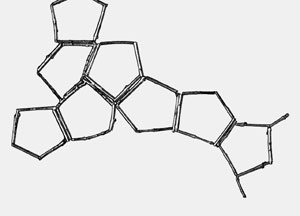
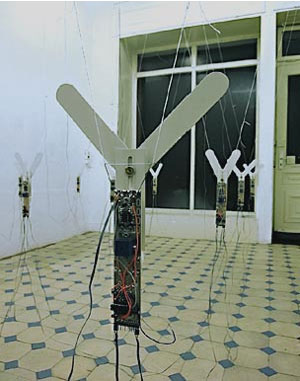
Foto: Hannelore Kober
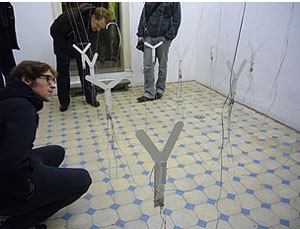
alle weiteren Fotos: Uta Weyrich
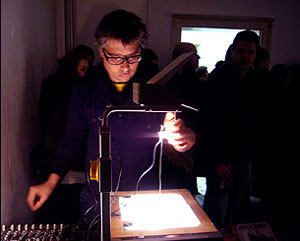
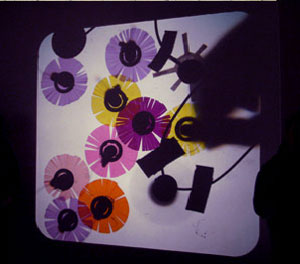
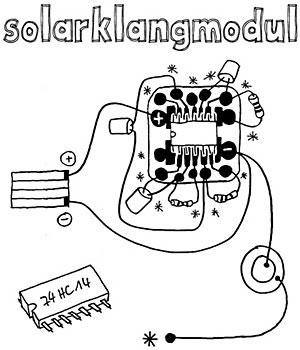
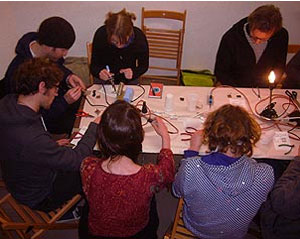
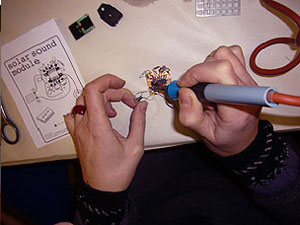
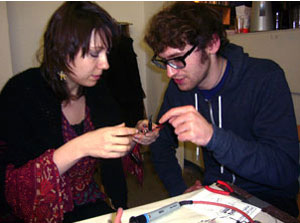
musik
für raupen / music for caterpillars (langsame Version)
Ralf Schreiber
Ausstellungseröffnung mit kleinem Konzert 12. Februar 2010 19.00
Uhr
Ausstellungsdauer: 13. Februar bis 5. März
Workshop Samstag, den 13. Februar 16-18h
Workshop Autonome Klangmodule
In einem Workshop konnten kleine eigensinnige Soundmodule gebastelt
und gelötet werden. Die Module bestanden aus einer simplen elektronischen
Schaltung, einer Solarpaneele und kleinen Lautsprechern. Sie generieren
leise, variable Klänge, die bisweilen an Vogel- oder Insektengesänge
erinnern.
Artikel in den Stuttgarter Nachrichten vom 18. 2. 2010:

Ralf Schreiber
music for caterpillars (slow version)
Ralf Schreiber works with electronics, solar panels, motors and miniature
loudspeakers. His playful and experimental works generate gentle sounds
and minute movements and in so doing explore low-energy transformation
processes (the transformation of light into movement and sound). Central
to his artistic practise is the long-term project "Living Particles"
which consists of ever-changing constellations of minute mini-robots
that communicate and interact with one another. A new variation of "Living
Particles" can be seen and heard in the Oberwelt gallery.
"Living Particles",
Autonomous Audio-kinetic Installations (2000-2010)
Ralf Schreiber constructs small modules and miniature robots with simple
analogue electronic circuits. Each unit is powered by solar cells and
functions autonomously generating quiet, irregular sounds and minute
movements. The individual modules are connected to each other to form
a complex system. The energy potential of each module and installation
is kept to a minimum, whereby the threshold is set so that there is
just enough energy for something to happen. Due to the limited power
supply from the solar modules an astable circuit is created and this
generates particular patterns of movement and sound that in turn form
a rhythmic and chaotic composition. A minimal approach is integral to
the work. What is the minimum energy, material, time and circuit complexity
that is required to acoustically fill a space?
Exhibition opening and small concert 12th February 2010, 7.00pm
Exhibition dates: 13th February - 5th March
Workshop: Saturday, 13th February 4.00-6.00pm
Autonomous Sound Module Workshop
In this workshop small sound modules with a mind of their own can be
built and soldered. The modules consist of a simple electronic circuit,
a solar panel and small loudspeakers. They generate quiet, variable
sounds that are evocative of birdsong and insects. The type of sound
depends on the intensity of light, but it changes even if the light
conditions do not.
At the same time each module has its own individual sound.
Prior knowledge of electronics is not required.